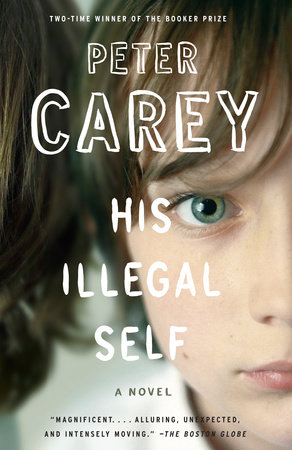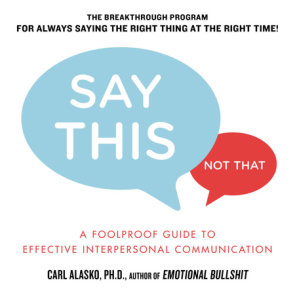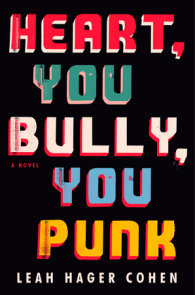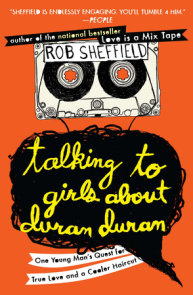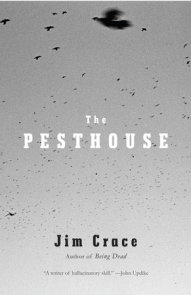TEACHING GUIDE
NOTE TO TEACHERS
A Teacher’s Guide to Peter Carey’s His Illegal Self
by Gabriel Packard
NOTE: Scroll down for a link to the PDF of this teacher’s guide.
Introduction
Fiction writers, like magicians, must conceal their techniques in order to make the illusions they create convincing. Even books that appear to lay bare the tricks of the author’s trade–such as Tristram Shandy and A Heartbreaking Work of Staggering Genius–simultaneously deploy other techniques, which remain hidden, in order to make their plots compelling, their characters empathetic, and to help the reader generally suspend disbelief. Without exception, every great novel is a well-stocked mine of concealed writing techniques, and by examining in depth the plot, structure, language and characters of well-written novels, the novice writer can extract many valuable lessons.
It is also safe to say that all great writers are also great readers of literature and that they borrow freely from the work of their predecessors. One of the best ways to train students how to read and learn from literature, in this way, is to select one novel and over the course of a semester investigate the various writing techniques it contains.
This Teacher’s Guide is designed to help you use Peter Carey’s His Illegal Self in just this way. Each section of the guide highlights a particular technique or aspect of this novel–point of view, voice, unreliable narration, concision, rhythm, and symbolism–and includes questions for discussion to help students analyze these aspects of the novel. Exercises are also provided that will help students use each of these fiction-writing techniques in their own writing.
This guide provides a semester’s worth of fiction-writing classes, structured around His Illegal Self. Each class centers on students discussing and reading aloud from exercises set the previous week. The sections of this guide may also be used individually to focus on a single aspect of the craft of fiction.
About the Novel
His Illegal Self, set in the early 1970s, tells the story of a seven-year-old American boy, Che, whose parents live in hiding in the U.S. because they are members of a revolutionary group. Che lives with his well-to-do grandmother in New York City, and in the novel’s opening sequence, a young woman named Dial collects him from his grandmother to take him to visit his mother. However, after learning that Che’s mother has died, Dial eventually ends up taking Che to a hippie commune in Australia. After they endure various hardships, Dial finally returns Che to his grandmother in America.
The novel is written in a pared-down prose style, and it frequently switches point of view–occasionally several times within a single paragraph. Carey skillfully handles this literary challenge in addition to a number of others, such as the notoriously difficult task of using the point of view of a child character to tell parts of the story, and not using quotation marks to signal direct dialogue.
Switching Points of View
His Illegal Self typically shifts point of view (POV) several times within a chapter (e.g. Chapters 1, 8, 46) and even, on occasion, several times within a single paragraph. See, for example, the opening paragraph of Chapter 48, which starts with a Jane Austen—style, distant-third-person POV aphorism, “It is a law of childhood . . .” and then zooms in during the sentence, “That’s how it worked for the boy . . .” and then settles briefly in close-third, from Che’s POV, with, “He was ashamed of himself already…” and then zooms out again to distant-third with, “He didn’t see Trevor…”
Students may become discouraged from attempting such rapid shifting of POV in their own work, due to concerns about confusing the reader. However, shifting POV several times in rapid succession can be accomplished without causing confusion as long as the writer, throughout the text, unambiguously signals which point of view is being employed. This can give the writer freedom to jump from one character’s consciousness to another’s, or to zoom out to an omniscient point of view. In this way, the writer can track the action from whichever point of view he or she feels highlights the most important aspect of the action, just as a movie director can switch between shots filmed by different cameras.
Questions
1. List each of the main points of view used in literary fiction (first person; second person; and third person, close or limited / objective /subjective / omniscient) and give a definition and an example of each.
2. Find a passage in His Illegal Self that switches point of view at least twice.
a. Identify each point of view used in this passage.
b. Note how, exactly, the writer signals which point of view is being used.
3. What are the benefits and dangers of switching point of view frequently?
Exercise 1
Write a scene or short story in which you switch between at least two different characters’ points of view and also use an omniscient narrative voice. Switch point of view mid-paragraph at least a few times, making sure that the POV remains clear throughout.
Exercise 2
Select a favorite or familiar scene from His Illegal Self, or any other novel, in which there is a single point of view and rewrite that scene using multiple points of view.
Writing from a Child’s Point of View
Writing from a child’s point of view is a notoriously difficult thing to do, in part because there is a danger of making the child’s thoughts and feelings come off as annoyingly precious, unrealistically intelligent, or not convincingly childlike. The writer must also address the fact that children generally have a limited understanding of the world and a limited vocabulary. While observing these constraints, it can be difficult to still reveal enough to make the story and the child character interesting and plausible.
Nevertheless, His Illegal Self overcomes these obstacles, by carefully limiting the child’s voice to revealing only things that a child would convincingly think, feel, observe, or do; and also by switching to adult characters’ points of view and an omniscient point of view, in order to reveal things that the boy Che couldn’t know, such as the nuanced social and legal pressures on Dial to return Che to his home in the United States.
A class discussion of this topic might compare His Illegal Self to extracts from other works of literature that successfully use a child’s point of view, such as Mark Twain’s Huckleberry Finn and Tom Sawyer; Ian McEwan’s Atonement; Mark Haddon’s The Curious Incident of the Dog in Night-time; or Roddy Doyle’s Paddy Clarke Ha, Ha, Ha.
Questions
1. What are the challenges associated with writing from a child’s point of view?
2. What are the benefits of writing from a child’s point of view? How can the limitation of a child’s understanding in fact become an opportunity? How can writing from a child’s point of view free the writer in terms of language, thought, humor, irony, etc.?
3. In His Illegal Self, how does Peter Carey transcend the limitations of a child’s point of view? Look at Chapter 14, for example: “What’s happening, the boy asked. No one heard him anymore” (p. 73). How does the writer convey more about the situation, here, than Che can comprehend, even though the chapter is written in close-third from Che’s point of view?
Exercise 1
Write a scene or short story entirely from a child’s perspective, using either a first-person or a close-third-person point of view. Find ways to reveal more about the situation than the child understands.
Withholding Information from the Reader
His Illegal Self misleads the reader, in some places, by deliberately withholding crucial plot information. The most notable example of this is when the reader is misled into believing that Dial is Che’s mother, and only later is it revealed that she is not. Withholding this critical information helps the reader to experience the events of the story from Che’s point of view, who is similarly misled into believing that Dial is in fact his mother. The reader, like Che, is generally one step behind knowing what is really going on in the plot. In this way, withholding information mimetically helps to evoke Che’s experience in the reader’s mind.
Questions
1. What information does the author withhold from the reader in His Illegal Self?
2. What is the purpose and effect of withholding this information?
3. How would the reader’s experience be different if this information were revealed much earlier?
4. In what ways is withholding information from the reader different from employing an unreliable narrator?
5. Provide other examples from literature in which information is withheld and discuss its purpose and effect.
Exercise 1
Write a scene or short story in which you withhold a crucial fact from the reader until the end of the story. Make withholding this information justified, for example by making it align the reader’s experience with that of the protagonist, as Carey does in His Illegal Self.
Dialogue and Quotation Marks
One of the most distinctive stylistic features of His Illegal Self is its lack of quotation marks, or any other punctuation (such as the Joycean em-dash), to signal the beginning or end of direct dialogue. Despite the assumption that quotation marks make the reader’s life easier, His Illegal Self manages clearly to signal which text is direct dialogue and which character is speaking, without the use of quotation marks. Carey achieves this largely through carefully wording the sentences to avoid ambiguity. Look, for example, at this dialogue between Dial and Rebecca on p. 166:
This is what you did to me, Rebecca said. You bring your cat into the valley. This is what you do. They’re sentient beings, she said, nudging a feathered corpse with her big toe.
They’re what?
In Buddhism, began Rebecca.
I know what sentient means.
Rebecca narrowed her eyes. Then you should know that your cat is destroying our environment and you’ve got a choice. You can get rid of this cat or we’ll get rid of you.
Note how clear it is that that first clause (“This is what you did to me”) is direct dialogue, despite having no quotation marks around it. Also note how clear it is that the last sentence in that paragraph is half direct dialogue “They’re sentient beings” and half narrative description “she said, nudging a feathered corpse with her big toe.”
It is a useful exercise for students to write the dialogue in their fiction, without using quotation marks, as this will force them to think carefully about how to compose clear, unambiguous, well-organized sentences–a universally important skill for any writer.
Questions
1. What is the effect on the reader, of having no quotation marks in His Illegal Self?
2. How specifically does Carey signal direct dialogue in the absence of quotation marks?
3. How does Carey use the rhythm of sentences to clarify where direct dialogue begins and ends?
4. What are the advantages and disadvantages of using quotation marks?
5. John Steinbeck’s novella Burning Bright is subtitled A Play in Story Form and was designed to allow the direct dialogue to be lifted directly from the text and performed on stage. Could His Illegal Self be considered “a play in novel form”? Does the lack of quotation marks add a theatrical element to His Illegal Self?
Exercise 1
Write a scene or short story with lots of dialogue, but without any quotation marks to signal where the dialogue begins and ends.
Exercise 2
Are other punctuation marks expendable, in the same way that quotation marks can be? Write a scene or short story with no punctuation other than periods, capital letters, and paragraph breaks. You might look at Carey’s True History of the Kelly Gang for an example of good, clear writing with minimal punctuation.
Or
Write a scene or short story with no punctuation at all. Make every sentence unambiguously clear.
Trimming the Fat
Another distinctive stylistic feature of His Illegal Self–and of Carey’s recent work, in general–is its lean sentences, paragraphs, and chapters. The text is trimmed down to its bare essentials, and the sentences are generally short and grammatically simple:
The Crystal Community had no money. Its members stared at her, away from her. A bare-bottomed blond-haired child pissed out from the edge of the floor. The pee went into the wild lantana, a long clean arc of crystal (p. 138).
In this paragraph Carey effectively describes the community in just four short sentences of 6, 8, 14, and 13 words, respectively, averaging 10.5 words. This is lean prose.
Questions
1. What is the effect on the reader, of using the spare prose style employed in His Illegal Self? What is gained? Is anything sacrificed?
2. Because everything is pared down to its bare essentials, when Carey gives a long, detailed description, it stands out. Look, for example, at the description of the Volvo in the tree on p. 145. What is the effect of spending so long describing this one object? What else is the writer conveying, beyond just describing the appearance of this car?
Exercise 1
Take a short story or chapter that you’ve written. Reduce it to one-third of its existing length. Delete all words, sentences, paragraphs, plot events, descriptions, etc., that aren’t absolutely essential.
Exercise 2
Take ten pages from a novel by Dickens, Thackeray, or another writer who tends to be verbose, and reduce that original ten-page extract to three pages, without losing anything essential. Analyze the effect of reducing the prose in this way. What exactly is gained and what is lost?
Exercise 3
Although the language Carey uses in his novel is pared down, it remains evocative, vivid and poignant, and it could be described as poetic. Take a short extract from His Illegal Self and then reformat it–without altering the words or punctuation–as a free-verse poem.
Rhythm
Fiction writers can alter the rhythm of their prose–and thereby help evoke mood, alter the pacing, and fine-tune the reader’s experience in a range of other ways–through varying sentence length and paragraph length, adjusting the mix of monosyllabic versus polysyllabic words, the frequency of adjectives, and so forth. Teaching students to hear the rhythms of their own work can be a rewarding exercise–both to help them become more aware of rhythm as readers experience it, in the silence of the page, and also to help students perform their own work aloud in an engaging way.
The rhythms in His Illegal Self can be best appreciated by listening to the author reading from it: http://www.themonthly.com.au/tm/node/940 (This recording is from the 2008 Adelaide Writers’ Week, in Australia.)
There are many tools at the writer’s disposal for controlling the rhythm of the words in a sentence. A writer can, for example, introduce parenthetic clauses and interjections, like this one, at particular points in the sentence to give the reader a little pause and thereby alter the sentence’s rhythm. The same thing can be done by carefully choosing the position of speech tags, such as “he said,” in direct dialogue, creating the effect of a pause in the character’s speech, and, again, altering the rhythm of the sentence. The writer can also control the rhythm through word choice, sentence structure, and sentence length, analogous to the way a poet controls the meter of a poem.
In order to fine-tune the rhythm of a sentence, a writer must first learn to hear rhythm. And the best way for a writer to hear the rhythm of his or her own sentences is to read them aloud, listening for anything that sounds awkward, repetitive, or that causes him or her to stumble.
When reading work to an audience, writers should underscore the rhythm of their language by varying the pitch, tone, and volume of their voice to express the nuances of the situation being narrated. Writers should also be careful to avoid the all-too-common “literary-reading drone” in which every line is delivered in the same sonorous pitch; this is designed to add gravitas to the words, but generally serves only to numb the minds of those listening.
Questions
1. What roles does rhythm play in prose fiction?
2. Identify and characterize the different rhythms of the language in His Illegal Self.
3. Discuss any passages in which you feel the rhythm is particularly pronounced or that it underscores the action or mood.
4. List some ways that writers can alter the rhythm of prose.
Exercise 1
Take a story or chapter that you’ve written or are currently working on and read it aloud at least ten times, each time rewriting any sentences in which the rhythm feels awkward. Print out before and after versions and bring them to read aloud in class. Be prepared to explain how your edits affected the rhythm and flow of your piece.
Exercise 2
Prepare a page of fiction to read aloud in an interesting and expressive way.
Exercise 3
Search online for recordings of writers reading their work aloud. Find examples of good and poor readings, and note what factors affected their quality.
Using the Weather and the Physical World
His Illegal Self is a book in which descriptions of the weather and the physical world do more than just inform the reader about temperature, light conditions, precipitation, and the appearance of the scenery. Rather, these descriptions invariably also evoke and underscore the atmosphere of the scene in which they feature and the psychological states of the protagonists. For example, Che’s positive feelings about being on a bus with a woman he believes to be his mother, are underscored by the description, from Che’s point of view: “The windshield glass was starred with sunlight” (p. 12). Carey could just as easily have described this windshield with a negative slant, for example, by writing, “The windshield glass was smeared with sunlight,” or “The sunlight showed the dirt on the windshield.” But these descriptions would have subtly suggested to the reader that Che’s psychological state was less positive and would have infused the scene with a different atmosphere.
Similarly, see how the following description of the unforgiving, parched landscape of the Australian bushland underscores Che’s feelings of isolation:
The boy looked out across the waving trees. Everything was hard and dry, dead leaves, cracking sticks, no mercy. He thought, This does not apply to me (Chap. 34, p. 171.).
Questions
1. In His Illegal Self what information does the writer impart when describing the weather and the physical world, beyond just telling the reader about the temperature, precipitation, appearance of the light, appearance of the scenery, etc.?
2. What is the advantage of conveying this additional information simultaneously to describing the weather and the physical world? Why not convey this additional information separately?
Exercise 1
Record your own observations of the weather in a weekly weather diary. Also note down good descriptions of the weather that you come across in literature. At the start of each class, one or two people will read from their weather diaries.
Exercise 2
Write a scene or short story in which descriptions of the weather evoke the atmosphere and the psychological states of the protagonist/s. You may like to draw from the observations you recorded in your weather diary to assist you.
Extended Symbols
Symbols help the writer to underscore specific aspects of the narrative. Here are two writers’ takes on how symbolism functions in literature:
… a symbol is like a rock dropped into a pool: it sends out ripples in all directions, and the ripples are in motion. Who can say where the last ripple disappears? One may have a sense that he at least knows approximately the center point of all those ripples, the point at which the stone struck the water. Yet even then he has trouble marking it precisely. How does one make a mark on water? (John Ciardi from How Does a Poem Mean?)
I think that for the fiction writer himself, symbols are something he uses simply as a matter of course. You might say that these are details that, while having their essential place in the literal level of the story, operate in depth as well as on the surface, increasing the story in every direction.
I think that the way to read a book is always to see what happens, but in a good novel, more always happens than we are able to take in at once, more happens than meets the eye. The mind is led on by what it sees into the greater depths that the book’s symbols naturally suggest. This is what is meant when critics say that a novel operates on several levels. The truer the symbol, the deeper it leads you, the more meaning it opens up. (Flannery O’Connor, from “The Nature and Aim of Fiction,” in Mystery and Manners: Occasional Prose)
You may like to share one or both of these quotes with your students.
His Illegal Self uses a number of extended symbols: symbols that recur in multiple scenes and that parallel the fluctuating dynamic of a particular element of a character or relationship, thereby subtly highlighting that element. Two examples:
1. Che’s cat, Buck, symbolizes Che himself. Dial’s fight to keep Buck in order to please someone other than herself parallels the way in which she reluctantly fights to keep Che to please the revolutionary group. Later, when Che gets lost in the bush, Buck gets trapped in the “Feral-Trappa” cat-trap. When the cat dies and Dial buries him, Dial also simultaneously believes that Che is dead. These parallels become gradually more explicit, until the characters themselves begin to notice them. Rebecca, for instance, makes the following comparison: “You can’t look after that cat. . . .You can’t even look after the kid” (p. 199) and Dial thinks: “She [Dial] killed her cat. She killed her boy” (p. 214).
2. The wooden fence palings that Dial nails to the inside walls of her cabin, but cannot get to lay flat, symbolize the futility of her situation in keeping Che in Australia. When she first shows the wood paneling to Che she tells him: “Those crooked nails are there to keep the boards flat while they dry. After that we’ll cover the space between with other bits of wood.” Whereupon Che immediately thinks, “He could not live here” (p. 190). Dial can pin neither the wood nor Che down, nor get them to fall into line with her plans.
Questions
1. What might Che’s cat, Buck, symbolize?
2. What might the wooden fence palings that Dial nails to her cabin walls be said to symbolize? What about the “crooked nails”? And the cabin itself?
3. Identify other symbols in His Illegal Self. Is there a consistency or connection among the symbols?
4. How does Carey integrate these symbols into the story without making them feel contrived? Do you agree with John Ciardi and Flannery O’Connor (see quotations above) that symbols work beneath the surface of a novel?
Exercise 1
Take a scene, chapter, or short story that you have written, and rewrite it introducing an extended symbol that underscores a particularly important aspect of one of the characters or relationships.
Endings
The ending of a story or novel needs to resolve plausibly the events of the plot in order to create the feeling of resolution and completeness that most readers expect from of a work of narrative fiction. This sense of resolution is achieved at the ending of His Illegal Self by having Dial return Che to America. This resolves Che’s main conflict: that he had been trapped in a place where he did not belong and where, despite achieving some personal growth, he could not integrate. It also resolves Dial’s main conflicts: that she, too, had ended up in a place where she did not belong and could not integrate, and also that she needed a way out of her increasingly untenable position of reluctant kidnapper. In addition, Che’s grandmother has her own conflict resolved: she sought the return of her beloved grandson, and, in the end, he is indeed returned to her.
Questions
1. What are the characteristics of a good ending?
2. Does the ending of His Illegal Self have these characteristics?
3. How might His Illegal Self have ended differently, but still achieved a satisfying conclusion to the story?
Exercise 1
Write an alternative ending to His Illegal Self. Take it from “At the Brisbane GPO there were police everywhere, like ants pouring from a nest” (Chap. 52, p. 258).
Using Research
Research can be a useful tool for the fiction writer. Its most obvious function is to provide background information on political, historical, and cultural context to help the writer avoid anachronisms and factual inaccuracies that may distract the reader and awaken him or her from the “vivid, continuous dream” (to borrow John Gardner’s phrase) that good fiction should induce. Research is also a good way for writers to find convincing descriptive details to sprinkle into the text to help create a sense of authority, even when writing about a subject, place, or time period they know little about. And research can even contribute to plot structure by presenting obstacles that the characters must work to overcome.
Here’s an example from His Illegal Self that demonstrates all three of the uses of research described above: In the early 1970s, Australian public pay phones didn’t allow international phone calls. This detail avoids a distracting anachronism for those familiar with the time period; it functions as a convincing detail that helps bolster the writer’s authority on that time and place; and it also serves as an obstacle that forces Dial to go to the Brisbane GPO (general post office), which is swarming with police, in order to make her phone call (p. 258), thereby putting herself in danger of getting arrested.
Research can also provide solutions to characters’ obstacles. In His Illegal Self, for example, the revolutionary group gives Dial a large amount of cash and a passport for Che to help her take him to Australia. And in writing the novel, Peter Carey researched U.S.-based revolutionary groups of the 1960s and 1970s, most notably the Weathermen, a group that aimed to overthrow the U.S. government and capitalism itself, via bombings, jailbreaks, riots, and other illegal activities. Members lived in hiding and commonly used fraudulently obtained passports.
Questions
1. Why do fiction writers need to conduct research? If they are writing fiction, why not just make everything up?
2. How, specifically, can factual errors undermine the reader’s experience of a work of fiction?
3. How can research help writers to create the illusion of having authority on a subject that they actually know little about?
4. Is it possible to do too much research for a piece of fiction?
Exercise 1
1. Some of the books that Carey used to research His Illegal Self are listed below. Look at one or more of these books (or other books on 1960s American revolutionary groups) and write a short story or a scene, based on your reading.
With the Weathermen: The Personal Journey of a Revolutionary Woman (Rutgers University Press, 2007) by Susan Stern. Memoir by a female member of the Weathermen
Push Comes to Shove: The Escalation of Student Protest (Houghton Mifflin Co., 1970) by Steven Kelman. Discussion of student protest movement in the 1960s. The Weathermen was a splinter group of the group Students for a Democratic Society.
The Whole Earth Catalogue (Whole Earth, various editions dating from 1968) by Stewart Brand. Wide-ranging “hippie” reference guide, popular in the 1960s and 1970s. Much of this can now be found online at www.wholeearth.com.
Exercise 2
Pick an article from The Whole Earth Catalogue (www.wholeearth.com) and base a scene or short story on it. Be sure to look at the “Free” sections (Free Money, Free Bus Rides, Free Phone Calls, etc.), which are a great source of descriptive details and solutions to obstacles. For example, from the September 1970 edition, p. 12:
Free phone calls: “A number 14 brass washer with a small piece of Scotch tape over one side of the hole will work in old style phones (also parking meters, Laundromat dryers, soda and other vending machines).”
Free money: “Panhandling nets some people up to twenty dollars a day. The best places are Third Avenue in the fifties and the Theatre District off Times Square. Both best in the evening on weekends. Uptown guys with dates are the best touch especially if they are just leaving a guilt movie like Guess Who’s Coming to Dinner?
Free bus rides: “Get on with a large denomination bill just as the bus is leaving.”
Exercise 3
During the course of the semester, research a specific event or person from the American 1960s revolutionary movement. Each week, a few people from the class will report on what they’ve found in their research. Write a fictional short story based on this research for submission at the end of the semester.
Mapping the Novel
Drawing up a visual representation of a novel’s plot and locales can be immeasurably helpful in illuminating its structure. The following exercise should be assigned to students near the start of the semester, so that students may think about the “shape” of the novel as they examine different elements of it. This exercise is intentionally open to interpretation, and students should be encouraged to interpret it freely.
Exercise 1
Create a visual representation–some kind of diagram–of the plot of His Illegal Self.
Some His Illegal Self Resources
Peter Carey discusses His Illegal Self on Australian TV
http://www.youtube.com/watch?v=N9Om5ZgB1SQ
Peter Carey discusses, then reads from, His Illegal Self at Adelaide Writers’ Week 2008:
Part 1: http://www.themonthly.com.au/tm/node/942
Part 2: http://www.themonthly.com.au/tm/node/940
Q&A with Peter Carey, about His Illegal Self
http://www.randomhouse.com/knopf/catalog/display.pperl?isbn=9780307263728&view=qa
About the Author of This Guide
Gabriel Packard has worked as a researcher for the novelists E. L. Doctorow and Peter Carey, and as an assistant to the literary agent Nicole Aragi. He holds a BA in English from Oxford University and an MFA in Fiction Writing from Hunter College, where he now works as Coordinator of the Creative Writing MFA Program. His journalism has appeared in more than one hundred publications worldwide including The Village Voice, The Writer magazine, Poets & Writers, and New York Magazine’s online edition. His awards include a Hertog Fellowship in fiction and the Miriam Weinberg Richter Memorial Award for Conspicuous Ability, which he received for his paper on a possible neurological basis for narrative structure. He is currently completing his first novel.
ADDITIONAL RESOURCES
http://www.randomhouse.com
×
Become a Member
Just for joining you’ll get personalized recommendations on your dashboard daily and features only for members.
Find Out More Join Now Sign In








